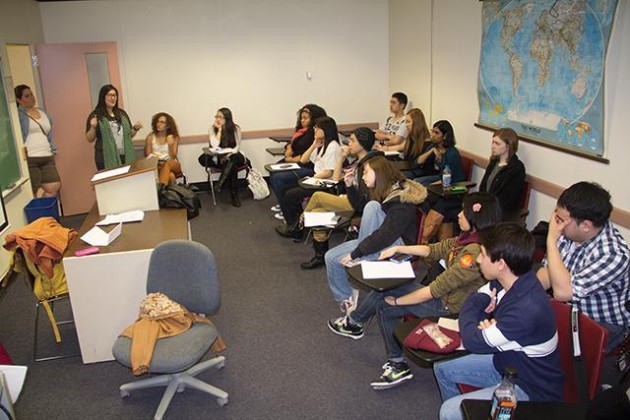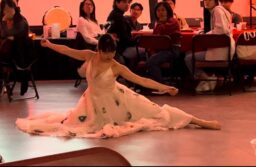
The Diversity Action Committee has expressed disappointment in the newest draft of the College’s Strategic Plan, which doesn’t name diversity as a specific goal but rather incorporates its themes and ideas in the other objectives in the document.
The Strategic Plan serves as a “roadmap” to help guide the College in executing its mission and allocate its resources, according to Brittany Goldstein, special assistant to the president.
“The Strategic Plan must guide the College over the next five years,” she explained. “Undergraduate education has grown more competitive while state and federal support of higher education has become scarcer, therefore colleges, Ramapo included, must focus on academic excellence while recognizing the need for efficiency, innovation and a market niche.”
Yesterday morning, the Diversity Action Committee (DAC) met with President Peter Mercer, Provost Beth Barnett and members of the student DAC group for an “On the Road” presentation of the Strategic Plan and to discuss their concerns.
The Strategic Plan Task Force, a group of 25 faculty, students, staff and administrators, began developing the new plan in January 2012. In September, the group endorsed a revised mission statement, three guiding principles and four planning goals for the Strategic Plan. But the latest draft of the plan, released March 1, included only three: to advance academic excellence and engagement, enhance financial strength and institutional sustainability, and improve internal and external relations and communications.
The fourth goal, to cultivate and support diversity and inclusiveness, had been dropped.
“We were very disappointed in the removal of the diversity goal,” said DAC co-chair Naseem Choudhury. “The existence of DAC is meaningless if diversity is not front and center in the mission of the College and in the values of the College and if there aren’t resources dedicated to meeting those missions and values and goals.”
Incorporating Diversity
Goldstein explained that the Strategic Plan Task Force (SPTF) broke into sub-groups to work on defining and detailing the strategic goals, objectives and achievement targets. Then, these groups present to the larger committee for more discussion.
When the team assigned to work on the diversity goal presented their ideas to the larger group, Goldstein said the task force felt much of their material was either unmeasurable or redundant.
“Diversity was originally included in the draft plan as its own goal,” she said. “However, the objectives and targets that were outlined under the goal were largely being measured in other ways throughout the document. Where the objectives and targets…were not already present elsewhere in the document, the Task Force added them.”
Thus, the SPTF decided to take what was outlined about diversity in the old goal and incorporate these ideas into other parts of the plan.
“We went through the document as a whole and we looked at each of the objectives and the targets of the diversity and inclusion goals,” Goldstein added, “and we said, ‘You know what, these are being achieved in other areas in the Strategic Plan, and they’re being measured. We tweaked the language and made some changes.”
‘Invisible Principles’
Yet many members of DAC felt doing so would dilute the importance of diversity in the College’s five-year outlook.
“We thought we were in a process to develop a Strategic Plan that reflects the values of all of Ramapo,” Choudhury said. “The diversity goal reflects values and principles that Ramapo was actually known for, and people really appreciated, and the folding in and hiding of these values and principles instead of making it upfront seems a little odd.”
As it stands now, the Strategic Plan notes that it “will continue to support and develop a diverse, highly qualified, engaged and accessible faculty,” work to “increase enrollment, retention and graduation rates among underrepresented groups,” strive to addressing “recruitment and retention of faculty and staff from historically underrepresented/marginalized groups,” and even “increase training related to discrimination.”
But, these themes are encapsulated in other strategic goals rather than falling under one comprehensive goal focused on diversity, Choudhury said.
“Basically, it felt very much like diversity and inclusion were just thrown in there without any qualitative or quantitative measures,” she explained. “We do not want diversity and inclusion to become invisible principles.”
Students present at the meeting agreed.
“As a student, I’m concerned. I’m part of the underrepresented population, and now I feel more than underrepresented, I feel undervalued,” said freshman Marissa Hatten, of the student DAC. “Issues of diversity should not just be small target goals or objectives.”
On a campus that many feel does not reflect our multicultural society, diversity is not always apparent in the Ramapo College community.
Spring 2013 demographics illustrate that 70.1 percent of the student body is Caucasian, followed by almost 11.8 percent Hispanic or Latino, 5.7 percent Asian and 4.5 percent black or African American.
“This campus is kind of a bubble sometimes,” said senior Janet Namkung, the co-president of United Asian Association. “We live in such a small bubble that everybody doesn’t realize there’s so much more out there, and people who can bring that to this campus might not be here because of something like this.”
Mercer addressed some concerns that the Strategic Plan has been reworked to take the focus off of diversity because the College feels it isn’t worthy of time, energy or resources.
“I’m as frustrated as you are by the perception…that we’re not devoting enough resources to diversity issues, because we devote several,” said Mercer.
Moving Forward
Provost Beth Barnett reiterated at the meeting that the College is still fully committed to diversity and inclusion, a key point in the mission statement, regardless of the language of the Strategic Plan.
“Diversity isn’t just important right now-it is the future of the College,” Barnett said. “I think we all realize that we can’t move forward without entertaining, celebrating [and] embracing the whole idea of diversity.”
The Strategic Plan defines diversity as “age, ethnicity, race, gender, religion, physical or mental abilities and disabilities, socio-economic status, viewpoint differences (e.g., political), sexual orientation, gender identity and national origin.”
Goldstein reiterated that the Strategic Plan is still in draft form, and the SPTF is currently collecting and getting feedback from various College stakeholders. Thus, the possibility of including diversity as an official, separate goal on the plan is still possible.
To view the entire draft of the Strategic Plan and to provide feedback, visit www.ramapo.edu/president/stratplan.
Additional reporting by Yovanna Garcia
—
nalliegr@ramapo.edu





